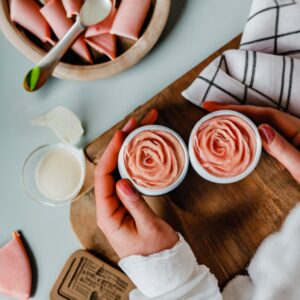
Pamper your skin with the rich essence of roses! Today, we bring you a delightful recipe for heavenly rose-scented lotion bars that promise to leave your skin feeling incredibly soft, smooth, and nourished. Lotion bars, with their solid yet luxurious texture, are a fantastic alternative to conventional lotions and creams. They stay solid at room temperature, ensuring ease of use and making them ideal companions for your travels.
What makes these lotion bars truly exceptional is their ability to create a protective shield on your skin, sealing in moisture without any unwanted greasiness. This recipe is a celebration of all-natural ingredients, steering clear of harsh chemicals and preservatives. Join us on this journey to craft a little piece of indulgence for your skin, embracing the soothing aroma of roses in every application. Get ready to elevate your skincare routine with the goodness of homemade, natural ingredients. Let’s dive into the art of crafting these rose-scented wonders!
Rose Lotion Bar Benefits
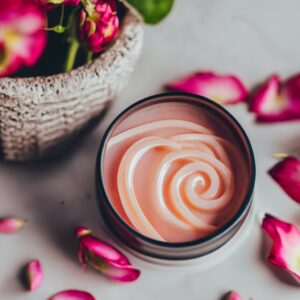
Indulging in a rose-scented lotion bar isn’t just a sensory delight; it’s a luxurious treat for your skin. Let’s explore the beauty benefits hidden within this delightful recipe:
- Deep Hydration: Rosehip seed oil, a key ingredient, is renowned for its ability to deeply hydrate and nourish the skin, leaving it irresistibly soft.
- Antioxidant Powerhouse: Roses, celebrated for their antioxidant properties, help combat free radicals, supporting the skin’s natural resilience against environmental stressors.
- Anti-Aging Elixir: Rose essential oil promotes skin elasticity, reducing the appearance of fine lines and wrinkles, for a youthful, radiant glow.
- Skin Regeneration: Rose clay contributes to gentle exfoliation, aiding in removing dead skin cells and promoting the regeneration of new, vibrant skin.
- Calming Aroma: The soothing scent of roses isn’t just a sensory pleasure; it also has aromatherapy benefits, promoting relaxation and tranquility.
- Convenient Application: Lotion bars, solid at room temperature, are mess-free and perfect for on-the-go hydration, providing a protective barrier without any greasy residue.
ROSE LOTION BAR RECIPE
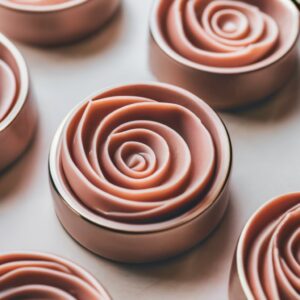
Indulge in the art of crafting luxurious rose-scented lotion bars with this delightful recipe. Elevate your skincare routine with the goodness of natural ingredients and the soothing aroma of roses.
Ingredients:
- Cocoa Butter (Deodorized): 40% | 3.6 oz. | 102 g
- Jojoba Oil: 30% | 2.7 oz. | 76.5 g
- White Beeswax: 24% | 2.16 oz. | 61.2 g
- BTMS-50 (Emulsifier): 5% | 0.45 oz. | 12.7 g
- Vitamin E: 0.5% | 0.045 oz. | 1.3 g (approx. 20 drops)
- Rose Fragrance Oil (or Essential Oils): 0.5% | 0.045 oz. | 1.3 g (approx. 20 drops)
- Dried Rose Petals
- Pink Mica Powder
Supplies:
- Silicone Rose Mold
- Heat-Resistant Bowl or Stainless Steel Double Boiler Pot for Melting Chocolate
Cook Time: 40 minutes
Additional Time: 1 day
Total Time: 1 day 40 minutes
Instructions:
Melt Ingredients: Gently melt beeswax, BTMS-50, and cocoa butter in a double boiler over low heat. Ensure complete melting by waiting until the oils are clear, a crucial step called “tempering.”
Extended Heating: After full melting, continue heating for an additional 15 minutes. Be cautious not to mistake visible absence of solid parts for complete melting, as invisible crystals may still need time. Tempering prevents graininess, akin to chocolate-making practices.
Prepare Mold: While waiting, ready your silicone mold. Crush a couple of dried rose petals between your fingers and sprinkle them over the mold cavities for an added touch of elegance.
Add Jojoba Oil: Once fully melted, stir in jojoba oil and keep heating until the mixture achieves clarity without any cloudiness.
Cool and Add Extras: Remove the melted oils from heat and let them cool for 3 minutes. Stir continuously during cooling. Add fragrance oil (or essential oils) and vitamin E, mixing thoroughly.
Pour into Mold: Pour the mixture into the silicone mold, filling 2 cavities.
Add Pink Hue: Mix a pinch of pink mica powder into the remaining mixture and stir well. Pour this into the remaining cavities for pink-colored rose lotion bars. Briefly reheat if oils start solidifying.
Set in Freezer and Refrigerate: Immediately place the tray in the freezer for 20-30 minutes to set and become opaque. Transfer it to the refrigerator for a couple of hours.
Finalize and Use: Remove from the fridge and let it reach room temperature overnight. Then, delicately remove the bars from the trays. Your exquisite rose cocoa butter lotion bars are now ready to be used and enjoyed!
COCOA BUTTER

Unlocking the Secrets of Cocoa Butter: A Skincare Marvel
Delve into the world of skincare excellence with cocoa butter, a precious gift from the cocoa bean. Explore the unique qualities that make cocoa butter a standout ingredient, offering a myriad of benefits for your skin.
Composition Insights:
- Rich in Stearic Acid: Cocoa butter boasts a high content of stearic acid, rendering it a firm and occlusive butter. While it turns brittle at room temperature, its rapid melting at body temperature ensures effortless absorption into the skin.
Skincare Marvel:
- Moisturization and Softening: Experience the indulgence of well-hydrated and softened skin as cocoa butter works its magic, leaving your skin supple and smooth.
- Protective Barrier: Craft a protective shield on your skin’s surface, safeguarding against moisture loss. This barrier enhances hydration levels, fostering elasticity and preventing the emergence of stretch marks.
- Relief for Skin Conditions: Find solace for skin ailments such as eczema and psoriasis as cocoa butter provides a soothing touch, contributing to the alleviation of discomfort.
Versatility Unleashed:
- Preventing Stretch Marks: Embrace cocoa butter’s effectiveness in preventing stretch marks, making it an ally in your journey to maintain skin resilience.
Application Mastery:
- Quick Absorption: Marvel at the seamless absorption of cocoa butter, swiftly integrating with your skin’s natural processes for optimal effectiveness.
Cocoa butter vs deodorized cocoa butter
This table provides an overview of the key characteristics of cocoa butter and deodorized cocoa butter, helping you make an informed choice based on your preferences and skincare needs.
| Characteristic | Cocoa Butter | Deodorized Cocoa Butter |
|---|---|---|
| Aroma | Distinct and rich chocolate aroma. | Mild scent, significantly reduced from natural cocoa butter. |
| Sensual Synergy with Rose Scent | Harmoniously blends with rose fragrance. | Retains the ability to complement rose scent effectively. |
| Fragrance Challenges | Intensity may be challenging to mask with additional fragrances. | Offers a neutral base for fragrance customization without the overpowering cocoa scent. |
| Moisturizing Properties | Excellent moisturizing and occlusive properties. | Retains all the moisturizing benefits of natural cocoa butter. |
| Suitability for Fragrance Customization | Limited due to the distinctive cocoa aroma. | Ideal for those who prefer a neutral base for customizing scents. |
JOJOBA OIL
Jojoba oil, with its skin-friendly composition and various benefits, is an excellent ingredient for skincare suitable for all skin types.
| Property | Jojoba Oil |
|---|---|
| Composition | Wax ester closely resembling skin’s natural oils. |
| Suitability for All Skin Types | Universally well-tolerated. |
| Antioxidant Content | Rich in vitamins A and E, omega-6 fatty acids. |
| Barrier Protection | Enhances skin’s natural barrier function. |
| Texture | Light, non-greasy. |
| Fragrance | Virtually scent-free. |
| Non-Comedogenic | Does not clog pores. |
BEESWAX
| Property | Beeswax |
|---|---|
| Role in Recipe | Hardening agent, keeps the lotion bar solid. |
| Benefits for Winter Skin | Acts as a protectant against harsh winter conditions, prevents dryness. |
| Moisture Sealant | Seals in moisture, beneficial for preventing dryness and irritation. |
| Visual Appearance | White beeswax results in visually striking white bars, can be colored with mica. |
| Color Variation | Yellow beeswax results in darker bars; with pink mica, it may have an orange hue. |
| Vegan Alternative | Candelilla wax can be used as a plant-based alternative, but has a yellow color. |
Substituting beeswax with Candelilla wax (vegan option)
If you prefer a vegan version of the lotion bars or want to create a rose lotion bar without beeswax, you can substitute beeswax with Candelilla wax. It’s important to note that using Candelilla wax will result in a more yellow-orange hue for the roses, as Candelilla wax itself is yellow.
Since Candelilla wax is harder than beeswax, it’s recommended to use a smaller amount. I propose modifying the recipe as follows: 50% Cocoa butter, 30% Jojoba oil, 14% Candelilla wax, 5% BTMS-50, 0.5% Vitamin E, 0.5% fragrance.
BTMS-50
BTMS-50 is widely recognized and appreciated for its use in hair conditioners and lotions. Surprisingly, it can also serve as a valuable ingredient in lotion bar recipes, contributing to a lavish and silky skin sensation. Functioning as a conditioning agent, it plays a role in minimizing greasiness while imparting a distinctive texture to the product.
Utilizing lotion bars containing BTMS-50 is particularly advantageous post-shower when the skin is damp. This is because BTMS-50 emulsifies oils on the skin, resulting in a creamy texture that enhances absorption.
How to substitute BTMS-50
I strongly recommend incorporating BTMS-50 into your lotion bar recipe. However, if you are unable to obtain it, you can easily substitute it by adding equal amounts of cocoa butter and beeswax. For instance, if the recipe specifies 12 g of BTMS-50, replace it with 6 g of cocoa butter and 6 g of beeswax.
VITAMIN E
Vitamin E oil into my oil-based formulations for its potent antioxidant and anti-aging properties. Recognized for its capacity to prolong the shelf life of oils, it enables me to savor the benefits for an extended period. Furthermore, Vitamin E oil acts as a shield for the skin against environmental stressors, contributing to a more youthful appearance.
FRAGRANCE OILS OR ESSENTIAL OILS
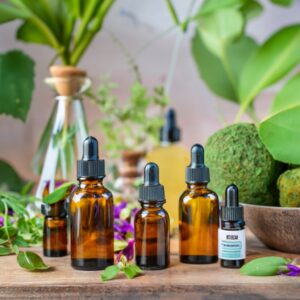
To give your homemade lotion bar a beautiful scent, you need to add either fragrance oil or essential oils.
If you want your DIY lotion bars to be fully natural, then opt for essential oils. If you want a cheaper option, opt for a fragrance oil.
If you decided to go with a fragrance oil, I recommend this rose fragrance oil for a long-lasting floral rose scent. If you prefer a different floral scent, I recommend peony fragrance oil.
If you prefer essential oils, for a rose scent, I recommend getting a Rose absolute essential oil blend in jojoba oil. It is diluted in jojoba oil because rose essential oil is very expensive and strong on its own.
| Ingredient Type | Recommended Product |
|---|---|
| Fragrance Oil | Rose Fragrance Oil |
| (for a long-lasting floral rose scent) | |
| Peony Fragrance Oil | |
| (for a different floral scent) | |
| Essential Oil Blend | Rose Absolute Essential Oil Blend in Jojoba Oil |
| (diluted for a balanced and cost-effective option) |
how to use a lotion bar
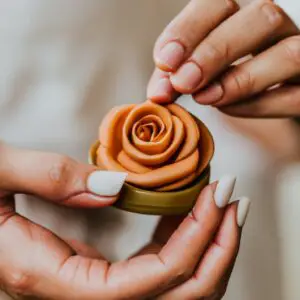
- Warm the Lotion Bar: Hold the lotion bar in your hands and allow your body heat to soften the surface. Alternatively, you can rub the bar between your palms or fingers to warm it up.
- Glide Over Skin: Once the lotion bar has softened slightly, gently glide it over the desired areas of your skin. The warmth from your body will melt the lotion, leaving a thin, even layer.
- Massage In: After applying the lotion, massage it into your skin using gentle, circular motions. This helps in better absorption and ensures that the moisturizing ingredients penetrate the skin.
- Focus on Dry Areas: Pay extra attention to dry or rough areas of your skin, such as elbows, knees, and heels. The lotion bar can provide targeted hydration to these specific areas.
- Allow Absorption: Give the lotion a few moments to absorb into your skin. It may feel slightly oily at first, but this sensation will diminish as the product is absorbed.
- Enjoy the Scent: If your lotion bar is scented, take a moment to enjoy the pleasant aroma. The scent can linger on your skin, providing a subtle and long-lasting fragrance.
- Store Properly: After use, store the lotion bar in a cool, dry place. If it’s a warmer environment, you might want to keep it in a tin or another container to prevent it from melting.
Shelf Life & Storage of a Lotion Bar Lotion bars have a good shelf life when stored properly:
- Keep in a cool, dry place away from direct sunlight and heat.
- Store in an airtight container or wrap in plastic to prevent exposure to air.
- Avoid leaving the bar in hot cars or humid environments, as excessive heat or moisture can compromise its texture.
- When stored correctly, lotion bars can last for several months to a year, depending on the ingredients used.
FAQ
Are Lotion Bars Good for Skin?
Yes, lotion bars are beneficial for the skin. They typically contain nourishing ingredients such as moisturizing oils, butters, and emollients that provide hydration, promote skin softness, and offer potential benefits like antioxidant and anti-aging properties.
What Is the Difference Between Lotion and Lotion Bars?
The main difference lies in their form and composition. Lotions are liquid formulations contained in bottles, while lotion bars are solid and often made with a combination of oils, butters, and waxes. Lotion bars are convenient, mess-free, and suitable for travel.
Are Lotion Bars Hygienic?
Lotion bars can be hygienic when used appropriately. Since they are applied directly to the skin, it’s advisable to use them on clean, dry skin to prevent transferring impurities. Personal use is recommended to maintain hygiene.
What Is the Advantage of Lotion Bar Over Liquid Lotion?
Lotion bars offer advantages such as portability, mess-free application, and reduced environmental impact (less packaging). They are solid at room temperature, making them convenient for travel, and their composition often includes natural ingredients.
Are Lotion Bars Worth It?
The worth of lotion bars depends on personal preferences and needs. Many people find them worthwhile due to their convenience, effectiveness, and eco-friendly aspects. They can be a valuable addition to a skincare routine.
How Long Should a Lotion Bar Last?
The lifespan of a lotion bar varies based on factors like frequency of use and the bar’s size. On average, a well-maintained lotion bar can last several months to a year.
Can I Remelt My Lotion Bars?
Yes, you can remelt lotion bars if needed. Gentle reheating can be done using a double boiler or a microwave in short intervals. This is useful if you want to reshape or combine multiple bars.
Can You Use Lotion Bars in the Shower?
It’s generally not recommended to use lotion bars in the shower, as water can compromise their texture. Lotion bars are best applied to dry skin after a shower or bath.
Are Lotion Bars Messy?
Lotion bars are designed to be less messy than traditional lotions. They are applied directly to the skin, minimizing the risk of spills or leaks associated with liquid lotions. Proper storage and usage can help maintain cleanliness.
